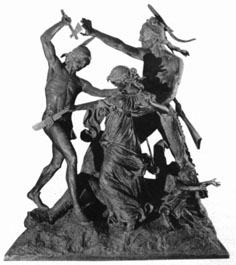<Reprinted
from Chicago
History, Spring 2004>
While "The Alarm" and "The Signal of Peace" both
portrayed the Indian as a vanishing but noble savage, the other stock
image
of the Native American was that of the war¬rior, dramatically
represented in Chicago's public space by the Fort Dearborn Massacre.
This monument memorialized the Potawatomi, Ottawa, and Chippewa
attack on the inhabitants of Fort Dearborn during the War of 1812.
The battle occurred among the sand dunes about a mile and a half
south of the abandoned fort.
In the
rout that followed, fifty three men, women, and children
were killed. The bodies lay where they fell for three years
after the battle. For several generations, the site was marked
only by the "Massacre Tree," a dead cottonwood looming
over the sand dunes. George Pullman, controversial industrialist
and inventor of the railroad sleeping car, pur¬chased the
site and built a mansion on the old battlefield in 1873. By
the 1880s, the Prairie Avenue location had become the most
elite neighborhood in Chicago and the faux castles of Gilded
Age industrialists surrounded the Massacre Tree. "Methinks
the place is haunted," a jour¬nalist speculated, "and
a subtle spell woven of dead men's bones attracts to the scene
of the massacre the pre¬sent representatives of a system
doomed to vanish like that of the redskins before the advancing
civilization of the new social era." As if to ward off
that prospect, Pullman donated the bronze sculpture group to
the Chicago Historical Society in 1893 to memorialize the dramatic
incident "for posterity."
|
|
"The Fort Dearborn
Massacre" (above, ca. 1912) became the most famous
of Chicago's Native American memorials. It depicts Black
Partridge's coming to the defense of Margaret Helm during
the massacre. |
|
|
|
"The Fort
Dearborn Massacre" (above, ca. 1912) became
the most famous of Chicago's Native American memorials.
It depicts Black Partridge's coming to the defense
of Margaret Helm during the massacre.
|
Follow this outside link to learn more about
Chicago's Fort Dearborn
|
The
sculpture was the work of Carl Rohl Smith, a Danish artist
drawn to Chicago to complete a commission
for the World's Columbian Exposition. Rohl Smith captured
one of the most famed legends of the Fort Dearborn disaster,
when Potawatomi Chief Black Partridge reportedly intervened
to save the life of Margaret Helm, wife of an officer in
the doomed garrison. The bronze group continued the "savage
warrior" imagery popular in the era. Although Black
Partridge is depicted as strong, commanding, and decisive,
the attacking warrior figure dominates the group. His tomahawk
is raised, poised to come down on the helpless white woman.
His gaze, riveted on his victim, seems pitiless, and his
action unstoppable; his fury overshadows Black Partridge's
mercy. |
The
foreground figures underscore the violence of the moment: a wounded
white soldier stabbed by an
Indian and a white toddler, vulnerable and helpless on the ground,
reaching his arms out for help. Rohl Smith included this haunting
figure to represent the dozen white children killed in the battle.
As if to draw the viewer to the image of the noble (instead of the
savage) Indian, Rohl Smith inscribed a legend on the base of the
monument: "Fort Dearborn Massacre/Black Partridge Saving Mrs.
Helm."
Forward to the next page of this essay
Back to the previous page
Back to Online Essays |



